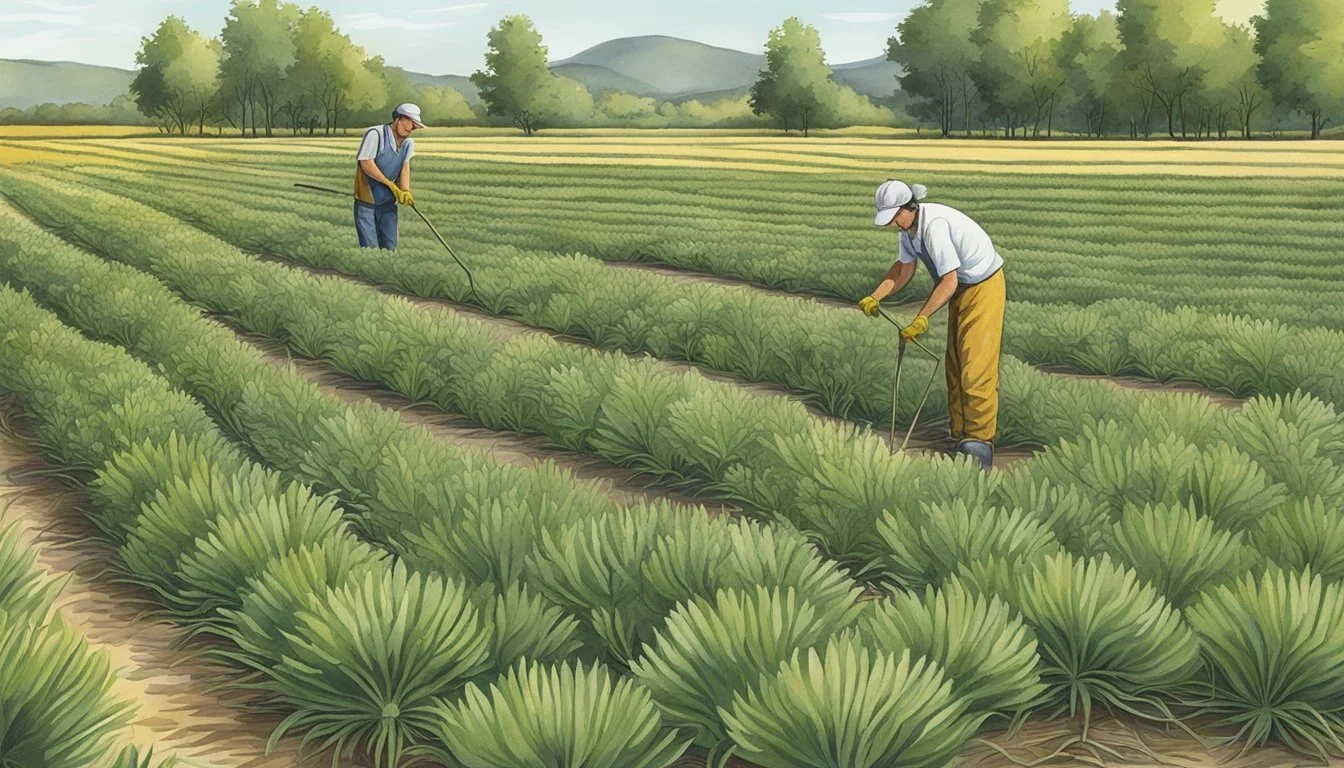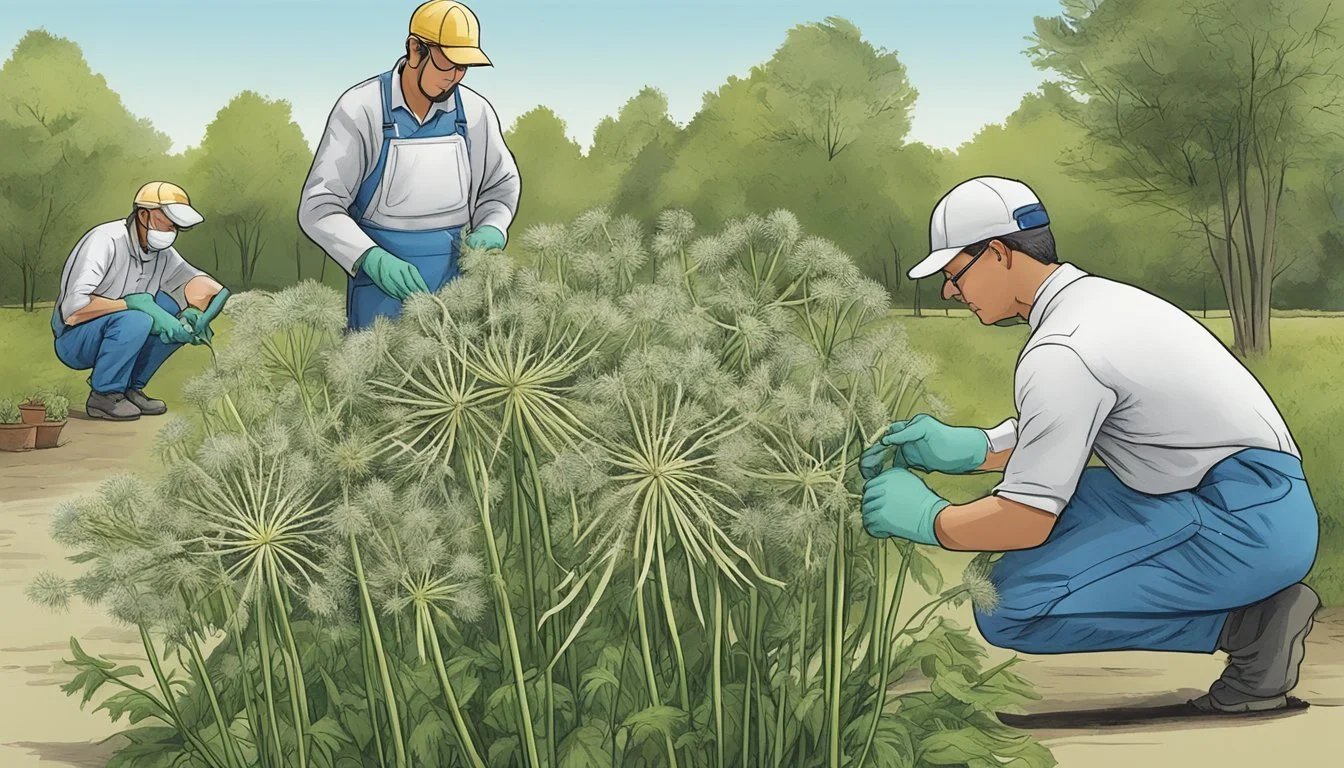Pest Control for Salsify
Effective Strategies for Gardeners
Salsify, often referred to as goatsbeard, is a vegetable known for its grass-like appearance and its edible taproot, which is a culinary delight to many due to its oyster-like flavor. While salsify can be a valuable addition to a garden, it is also a plant that requires careful pest management. The slender, pointed leaves and milky juice that characterize young salsify plants give way to more mature specimens that are upright, stemming from a long taproot and growing one to three feet tall with the potential for branching.
Effective pest control for salsify involves an understanding of the plant's growth cycles and the potential pests that could impact its health and yield. The robust taproot is the most prized part of the salsify plant and should be protected from common subterranean pests like root maggots and nematodes, which can compromise the crop. Above ground, salsify can attract various insects such as aphids and flea beetles, which can be managed through Integrated Pest Management strategies.
Addressing pest issues in salsify cultivation is made more complex due to the delicate balance needed to avoid harming the plant while targeting the pests. Methods range from biological controls, such as beneficial insects that act as natural predators to the pests, to careful application of pesticides that minimize harm to the salsify and the environment. In any case, vigilance and a proactive approach are key to ensuring that salsify thrives and contributes its unique flavor to the range of vegetables available for cuisine.
Understanding Salsify
Salsify is a unique plant that offers both ornamental beauty with its yellow flowers and practical uses, primarily as a root vegetable. This section explores its botanical characteristics, historical importance, and nutritional benefits.
Botanical Profile
Salsify, which encapsulates species such as Tragopogon porrifolius (common salsify or purple salsify) and Tragopogon dubius (yellow salsify or western salsify), is a member of the asteraceae family. These plants are characterized by their grass-like leaves and striking flowers, typically yellow or purple. They can be biennial or perennial plants with a significant taproot. Tragopogon dubius is known for its yellow flowers and, similar to others in the genus, it releases a milky juice when cut.
Black salsify (Scorzonera hispanica), also known as sandwich island salsify, differs slightly with smoother, darker foliage and flowers. Another related variety commonly referred to as goatsbeard, is known for its feathery and ornamental seed heads.
Historical Significance
The different salsify species such as the purple salsify and goatsbeard found their origins in Europe. They spread across the continent and beyond primarily for their edible qualities. Dubbed the oyster plant due to the flavor of its cooked root, salsify was a popular vegetable in 19th century Europe and was often grown in gardens to be used as a root crop.
Nutritional Value
Salsify is noteworthy for its nutritional value, offering a range of vitamins and minerals. As an edible root, it's rich in dietary fiber and contains vitamins B6 and E. The roots of salsify are consumed much like any other root crop. Additionally, the plant's edible flowers may also offer nutritional benefits. However, both purple salsify and black salsify are distinct in their exact nutritional composition.
Cultivation Tips
Proper cultivation is crucial for growing salsify successfully. This section provides focused advice on soil preparation, planting techniques, understanding the importance of climate, and maintenance necessary for a healthy salsify crop.
Soil Preparation
For salsify, a taproot vegetable, loose and well-draining soil is essential. It is best to prepare a bed with a mix of organic compost and sand to encourage deep root development. Aim for loamy soil with a pH between 6.0 and 6.8. Prior to planting, till the soil to a depth of 8 to 12 inches, removing any stones or debris that could impede the growth of the taproot.
Sowing and Planting
Salsify seeds should be planted directly in the ground as early as 2 weeks before the last expected frost. Sow the seeds ½ inch deep, spacing them 2 to 3 inches apart. Once seedlings emerge, thin them to stand 6 inches apart to allow adequate room for growth. Thinning is important to prevent overcrowding and promote a healthier taproot.
Climate and Season
Salsify requires a cool growing period, making spring the optimal time for planting in most regions. In warm climates, salsify can also be planted in the fall for a winter harvest. The plant thrives in areas with mild winters, as salsify can tolerate light frosts, which can even enhance its flavor.
Maintenance and Care
Regular maintenance includes watering, especially during dry spells, to maintain an even supply of moisture. Weeding is necessary to reduce competition for nutrients. Salsify can be susceptible to pests and diseases common to root vegetables, so monitoring and proactive treatment are recommended. Though not heavy feeders, a balanced fertilizer can be applied during the growing season to support growth. When the foliage begins to die back, it is an indicator that it's nearing time for harvesting.
Pest Management
Efficient pest management for salsify involves early detection of pests, proactive preventive practices, and the application of treatments that minimize harm to beneficial insects and the environment.
Identifying Common Pests
Common pests targeting salsify include the salsify armyworm, which can be effectively managed through vigilant monitoring. They typically manifest as small larvae that require prompt identification for adequate control.
Preventative Measures
Preventative strategies are crucial in maintaining the health of salsify plants. Integrated Pest Management (IPM) is a sustainable approach that includes crop rotation and the introduction of beneficial insects that prey on harmful pests. Cultural practices like mowing to control weed populations and the strategic application of herbicides can prevent pest infestations. Selective herbicides like 2,4-D and dicamba may be used judiciously to target specific weed species without affecting the salsify.
Treatment Solutions
When pests exceed acceptable thresholds, treatment solutions are necessary. Bacillus thuringiensis is one chemical control option that acts slowly on armyworm larvae, often requiring multiple applications. For larger infestations, mechanical methods such as hand-pulling weeds may be more appropriate. However, one should always consider the potential impact of treatments on non-target species and opt for the least disruptive methods possible.
Harvest and Post-Harvest
When it comes to salsify, understanding the right time to harvest and how to handle the crop post-harvest is crucial. Proper timing can enhance the root's flavor, while correct post-harvest handling ensures the longevity of its freshness.
Optimal Harvest Time
Harvest time for salsify is pivotal; it is typically ready in the fall, after a growth period of 120 to 150 days. They are best harvested when the foliage begins to die back and has been exposed to a few light frosts, which can improve the flavor of the taproot. It's important to note that the roots can reach up to 12 inches in length and should be handled carefully to avoid damage.
Post-Harvest Handling
Once harvested, cleaning and storing salsify properly is essential to maintain quality. The roots should be gently cleaned with water to remove soil without damaging the skin. For storage, trim the foliage about ½ inch above the taproot. Salsify should be stored at a temperature of 32 degrees Fahrenheit with a relative humidity of 95 to 98 percent to ensure optimal preservation. It can also remain in the ground through the winter for spring harvest if well mulched.
Seed Saving
Salsify can provide seeds for future planting if allowed to overwinter and produce seed heads the following summer. Once the seed heads have matured and dried, they should be collected before they become wind-dispersed seeds. Seed production requires careful monitoring as the seeds mature to avoid loss. The harvested seeds should be stored in a cool, dry place and can be used for sowing in the next planting season.
Culinary Uses
The versatile root vegetable salsify, known for its artichoke-like flavor, has been savored in kitchens for centuries, finding its place in various recipes. Whether it’s incorporated into hearty stews or served as a unique side dish, salsify is a delightful addition to any culinary repertoire.
Salsify in the Kitchen
Salsify is often referred to as the oyster plant due to its subtle flavor reminiscent of oysters (What wine goes well with oysters?). It's a root vegetable that thrives in the kitchen, bringing a distinctive taste to dishes that is both earthy and delicate. In the kitchen, salsify is noted for its versatility. One can find it being boiled and mashed, much like a potato, or incorporated into soups and stews to add depth and a slightly sweet, nutty flavor.
Recipe Ideas
Soups and Stews: Salsify is excellent for enhancing the flavor of soups and stews. It pairs well with other root vegetables and meats, contributing to a complex taste profile.
Salads: When sliced thin and boiled, salsify can be chilled and added to salads. It provides an interesting texture and flavor that elevates simple salad recipes.
Fried Salsify: For a crispy treat, salsify can be coated in a light batter and fried until golden. It’s often enjoyed as a snack or a side dish.
Alternative Preparations
In addition to boiling and frying, salsify can be roasted to bring out its natural sugars, or it can be included in a gratin for a creamy, cheesy delight. A traditional preparation known from the Sandwich Island is to mash salsify after cooking, which can then be used in patties or croquettes. This root vegetable also performs well when pickled, offering a sharp tang that complements the salsify's subtler notes.
Frequently Asked Questions
Managing pests in salsify crops requires understanding the specific challenges and implementing targeted strategies.
How can I effectively manage pests in my salsify garden?
Effective pest management in salsify gardens involves regular monitoring, timely interventions, and integrated pest management practices. Starting with healthy soil and resistant varieties is key to reducing pest problems.
What are common pests that affect salsify crops and how to combat them?
Common pests include root-feeding insects and foliar pests like aphids. Control methods may involve crop rotation and the use of insecticides, but specific treatment should be based on identification of the pests involved, as noted by Montana State University.
Are there any natural pest control methods for protecting salsify plants?
Natural pest control methods such as introducing beneficial insects, using botanical pesticides, and applying cultural practices can protect salsify plants. For instance, beneficial nematodes can help control root-feeding insects.
What are the best practices for preventing pest infestations in salsify?
Preventing pest infestations includes keeping the salsify garden clean, avoiding over-watering, using disease-free seed, and rotating crops to break pest cycles. Proper sanitation and minimizing habitat for pests will also aid in prevention.
Can companion planting help control pests in salsify cultivation?
Companion planting can attract beneficial predators or act as trap crops for pests. For example, planting marigolds may deter certain nematodes and planting strong-smelling herbs can confuse pests seeking out salsify.
What are the signs of pest damage on salsify plants?
Signs of pest damage on salsify plants include wilted or yellowing leaves, hole-ridden or chewed foliage, and poor growth. The presence of insects on the plant or in the soil around the roots may also indicate an infestation.








